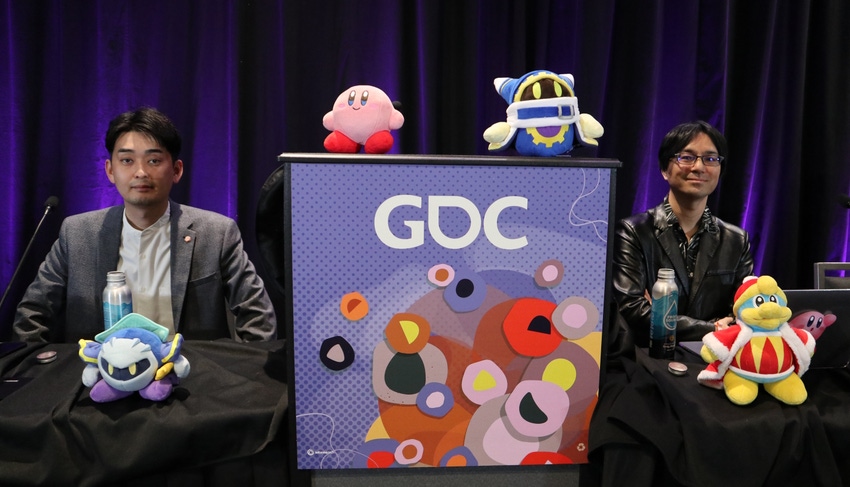.png?width=700&auto=webp&quality=80&disable=upscale)
Series directors deconstruct big Kirby changes in a 3D adventure and a 2D remake.

As the legendary Kirby game series approached its 30th anniversary in 2022, its executive director at HAL Laboratory decided to celebrate the occasion by "taking on a new challenge." In a GDC 2023 presentation that he co-hosted, Shinya Kumazaki led a packed audience through a two-game retrospective, to explain how the simultaneous production of a brand-new 3D game and a 2D remake took different paths to fulfilling the same Kirby series imperative: "approachable, yet deep."
The presentation began with a revealing look at the 2022 game Kirby and the Forgotten Land, which began development shortly after the launch of 2018's Kirby Star Allies. But a mere four-year development window betrays the work HAL put into the series' biggest transformation in its history.
Its okay to stretch!
"The process went beyond the development of a single title," Kumazaki said while standing beneath a slide that featured various 3D modes and mini-games through the series' history, ranging from the 2003 racing game Kirby's Air Ride to select sections of Star Allies. "We accumulated experience little by little."
While those experiments helped HAL's staff tiptoe into 3D-related development challenges, Kumazaki knew they paled compared to those that a team would encounter while crafting a feature-length 3D game. And such a game would have to appeal to newcomers, just like every other major Kirby game over the series' history. Thus, before HAL began plotting any levels or art design, then, they needed to nail down a fun concept that would take the series somewhere new, whimsical, and accessible.
One idea that stood out during the prototyping phase was an extreme extension of the squishy, malleable animations that Kirby had showcased as far back as the N64 era. "We reconsidered Kirby's characteristics," Kumazaki said. "Kirby is a strange creature: soft like a rubber ball, can take on a variety of shapes, and is totally fine even if stretched or pulled."
Instead of torturing their poor mascot, however, HAL's developers combined Kirby's quirky body trait with his classic enemy-inhalation ability. What if he inhaled something so big that it changed his whole form? Maybe that could enable new abilities—and early on, the devs prototyped traits like gliding and steamrolling. It's at this point that the developers thought it'd be more fun for players to inhale real-life objects, so that he would take on the properties of familiar objects like cars or sets of stairs.
With that mechanic in mind, HAL's team knew it'd need a setting where Kirby could freely inhale massive, real-world objects without scaring a bunch of virtual humans. The team solved this by putting Kirby inside an abandoned civilization, where such objects were left unattended and free for Kirby to inhale and make use of. "We didn't start with the visuals or the setting," Kumazaki said. "Instead, we started with the game design. Both 'mouthful mode' and the new world were conceived in order to create a new kind of 3D action that took advantage of Kirby's flexibility."
Homing in on Kirby's new auto-aim
Another HAL director, Tatsuya Kamiyama, took the stage to explain how his team invisibly empowered and guided Forgotten Land players. In their efforts to translate traditional Kirby action to a 3D world, HAL ran into an issue when players engaged in the classic Kirby practice of inhaling and spitting enemies or objects as a standard attack.
In 2D Kirby games, this common action is as easy as aiming from side to side, but a 3D camera positioned behind the spherical Kirby will frequently obfuscate which way he's aiming. "When you rotate a sphere, you can't really tell that it's been rotated," Kamiyama said, as opposed to the shapes and textures that make all 3D angles of Mario or Link immediately evident. And if a player misses an inhale-and-spit attack because they can't immediately ascertain their aim, they "need to look for another enemy to inhale, which is very frustrating," Kamiyama noted.
HAL's solution to this problem was a homing-attack system, which takes special care to hide how it's working from players. First, it decides which enemy or object to aim an attack at by assigning numerical points to every on-screen entity. An enemy that's immediately about to hit Kirby gets the most points; then "boss"-caliber enemies; then those who are being directly aimed at by a player's joystick direction. Homing attacks also change if Kirby is on the ground or in the air; in the former case, they don't home in on airborne targets, and in the latter, they home in on airborne enemies no matter how different their altitudes are.
After this math is calculated, attack trajectories are adjusted with a two-part pass that makes each shot look as much like straight lines as possible. Beyond these considerations, if an attack looks like it should hit because of a misleading 3D camera angle perspective, HAL counts it as a hit.
One way to deal with invisible walls
The guiding philosophy behind both games in HAL Laboratory's GDC 2023 presentation: make Kirby the hero!
Like other Kirby games with 3D elements, Forgotten Land denies its players access to discrete camera controls, so that series newcomers and novice gamers don't need to move a camera with one joystick while moving Kirby with the other. Level designers track all camera possibilities along a rail, and this tracking fudges the camera to center important elements like enemies and ideal walking paths, as opposed to keeping Kirby close to the middle of the screen at all times.
This design decision also solved HAL's worries about players using Kirby's flying ability, which has no limits or stamina bar, to explore all corners of a level. ("As a developer, can you think of a more terrifying ability?" Kamiyama joked to the developer-filled crowd.) As an example of a worst-case scenario, a debug-mode demonstration showed Kirby flying off screen toward an endless pit, only to be constrained by an invisible wall. Forgotten Land players never actually see the game's invisible walls, however, as Kirby can never run or fly past the view shown in the game's camera-on-rails system.
Secret prototypes, and a deep dive into Magolor
Concept art from Kirby's Return to Dream Land Deluxe
A discussion about 2023's Return To Dream Land Deluxe, a remake that was developed as part of the Kirby 30th anniversary celebration, rewound to the game's original 2011 launch on the Wii. Kumazaki confirmed that HAL Laboratory had spent a whopping 11 years trying and failing to create a new console entry in the series before completing that game. At this point, three prototype images, shown for the first time ever, quickly flashed on the GDC screen, including one top-down, Air Ride-like scene and one hand-drawn 2D action sequence.
The presentation's remaining focus was on Return to Dream Land and its remake, not those prototypes. Kumazaki explained how that 2011 game instituted a number of systems hidden from players to make them "feel like a hero," in terms of not punishing players if a jump, attack, or dash command was entered either a few frames too early or a few frames too late.
After breaking down the game's hand-crafted cel-shaded graphics, which HAL optimized to reduce bold outlines in favor of subtler, more handsome shadows, Kumazaki presented a wealth of concept art for Magolor, a main character created for the 2011 game. The top-most image (above) includes different initial designs by the art team. The second and third images are part of HAL's internal style guide, and Kumazaki pointed to them as a successful translation of the mysterious character's duality: "something about him makes you want to protect him, but there's also a hint of shadiness," he said.
Kumazaki concluded the panel by breaking down the combo-heavy combat of a new Magolor-focused mode in the game's 2023 remake. This mode, much like the other concepts presented at GDC, was tuned to make even novice players feel hyper-powerful; in this case, players benefited from a specially tuned "combo" system that counts hits in a combo meter before they actually connect with a foe. With this implemented, even novice players can keep Magolor's combat combos going for longer, Kumazaki said.
Read more about:
FeaturesAbout the Author(s)
You May Also Like









